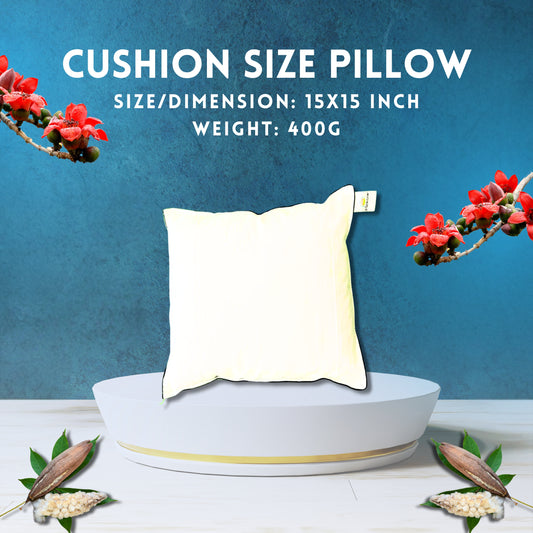Choosing the right pillow is essential for quality sleep and overall well-being. If you're exploring natural pillow options, you've likely come across Organic Buckwheat Pillow Vs Organic Kapok Pillow. Both are eco-friendly, chemical-free, and designed to provide excellent support. However, which one is most appropriate for your requirements?
In this guide, we’ll break down the top differences between buckwheat pillow and kapok pillow, discuss their pros and cons, and explain why kapok is better than buckwheat fibre for many sleepers.
What is an Organic Buckwheat Pillow?
An organic buckwheat pillow is filled with buckwheat hulls, which are the hard outer shells of buckwheat seeds. These pillows have been traditionally used in Japan and other Asian countries for their firm support and breathability.
Key Features of Buckwheat Pillows
- Firm Support – Conforms to the shape of your head and neck, promoting proper spinal alignment.
- Adjustable Loft – You can remove or add hulls to adjust the height and firmness.
- Natural Cooling Effect – The air gaps between the hulls allow for better airflow, preventing overheating.
- Long Lifespan – With proper care, buckwheat pillows can last 7–10 years.
Who Should Choose a Buckwheat Pillow?
- Back sleepers who need firm support
- Hot sleepers who want a breathable pillow
- People with neck pain looking for structured support
However, buckwheat pillows are heavier and can make a slight rustling sound when you move, which may not be ideal for light sleepers.
What is an Organic Kapok Pillow?
An organic kapok pillow is filled with kapok fiber, a soft, silky, and lightweight material derived from the seed pods of the kapok tree. This fiber is often considered a vegan and sustainable alternative to down feathers.
Key Features of Kapok Pillows
- Ultra-Soft & Plush Feel – Mimics the feel of a luxury down pillow.
- Hypoallergenic & Chemical-Free – Naturally resistant to dust mites, mold, and bacteria.
- Lightweight & Fluffy – Easy to adjust and doesn’t feel heavy.
- Eco-Friendly & Sustainable – Harvested from trees without harming the environment.
Who Should Choose a Kapok Pillow?
- Side and stomach sleepers who prefer a soft, cushioned feel
- People with allergies who need a hypoallergenic pillow
- Those who dislike heavy pillows and want something easy to handle
Kapok pillows, however, may require frequent fluffing as the fiber tends to compress over time.
Top Differences Between Buckwheat Pillow and Kapok Pillow
To help you decide, let’s compare them side by side:
|
Feature |
Buckwheat Pillow |
Kapok Pillow |
|
Firmness |
Firm and structured |
Soft and plush |
|
Support |
High, excellent for neck pain |
Moderate, gentle cushioning |
|
Weight |
Heavy |
Lightweight |
|
Breathability |
Excellent, stays cool |
Moderate, retains some heat |
|
Noise |
Slight rustling sound |
Completely silent |
|
Adjustability |
Can add/remove hulls |
Can adjust fill to preference |
|
Durability |
7–10 years |
3–5 years |
|
Maintenance |
Requires occasional refill |
Needs fluffing over time |
|
Best for |
Back sleepers, hot sleepers |
Side and stomach sleepers |
Both pillows serve different purposes, but if you’re looking for lightweight comfort and silence, kapok is the better choice.
Why Kapok is Better Than Buckwheat Fibre?
While both are natural and organic options, here’s why kapok is better than buckwheat fibre for many sleepers:
1. Softer & More Comfortable
- Kapok has a luxurious, cloud-like softness, making it perfect for those who want a plush pillow.
- Buckwheat, on the other hand, is firm and takes time to adjust to.
2. Completely Silent
- Buckwheat hulls make a rustling noise when you move.
- Kapok pillows are 100% noiseless, ideal for light sleepers.
3. Lightweight & Easy to Handle
- Buckwheat pillows can weigh 5–10 lbs, making them cumbersome to move.
- Kapok is ultra-lightweight, making it easier to adjust during the night.
4. Hypoallergenic & Chemical-Free
- Kapok is naturally resistant to dust mites, mold, and bacteria.
- Buckwheat can attract moisture, potentially leading to mold growth if not properly cared for.
5. Best for Side & Stomach Sleepers
- Kapok offers soft, cushiony support, which is ideal for these sleeping positions.
- Buckwheat’s firmness may be uncomfortable for side and stomach sleepers.
For those prioritizing comfort, softness, and ease of maintenance, kapok is a superior choice.
Which Pillow Should You Choose?
The best pillow depends on your personal sleep preferences. Here is a brief guide to assist you in making a decision:
Choose a Buckwheat Pillow If:
- You need firm, structured support.
- You are a back sleeper or experience neck pain.
- You want a cooling, breathable pillow.
Choose a Kapok Pillow If:
- You prefer a soft, plush feel.
- You are a side or stomach sleeper.
- You need a lightweight, hypoallergenic pillow.
Conclusion
Both Organic Buckwheat Pillow Vs Organic Kapok Pillow have their unique advantages. Buckwheat pillows are great for those needing firm support and breathability, while kapok pillows provide softness, silence, and hypoallergenic benefits.
If you prioritize plush comfort and a lightweight, noise-free experience, kapok is the way to go. But if you prefer firm support and better airflow, buckwheat is a great option.
Ultimately, the right pillow is the one that suits your sleeping position, comfort preferences, and health needs. Choose wisely for a restful sleep.
FAQs
1. Which is better for neck pain – buckwheat or kapok?
Buckwheat pillows provide better neck support due to their firm, moldable nature. Kapok pillows are softer and may not offer the same level of support.
2. Are kapok pillows hypoallergenic?
Yes, kapok is naturally resistant to dust mites, mold, and bacteria, making it a great option for allergy sufferers.
3. Do buckwheat pillows last longer than kapok pillows?
Yes, buckwheat pillows last 7–10 years, whereas kapok pillows typically last 3–5 years before needing replacement.
4. Can I wash a buckwheat or kapok pillow?
You can wash the outer cover of both, but avoid washing the buckwheat hulls and kapok fiber, as moisture can damage them.
5. Which pillow is better for side sleepers?
Kapok pillows are better for side sleepers as they offer a softer, more cushioned feel. Buckwheat pillows may feel too firm.











